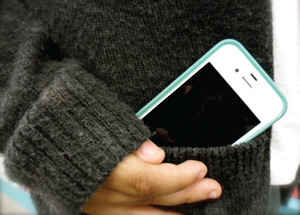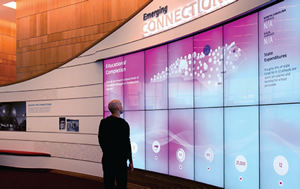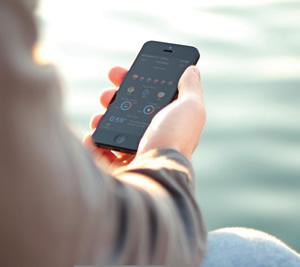Communication Tools: Meeting Expectations

PHOTO COURTESY OF GWYNETH ANNE BRONWYNNE JONES
Students today fully expect technology to be in place to assist with their educational and personal communication needs. Arriving with cell phones, tablets and laptops, they take for granted the ability to access the Internet wirelessly, send and receive email and text messages at will anywhere on campus, and have apps at their fingertips that meet their communication needs.
Similarly, campus staff fully expect technology to be in place providing a variety of communication options to enable them to fulfill their professional responsibilities. While staff may not be the digital natives that students are, they’ve nonetheless used technology enough that they can’t imagine completing their work without it.
Fortunately, technology has expanded and improved — and campus administrators have embraced it — to the point where both groups’ communication expectations are readily met. Here’s a quick look at some of the tools used on campuses across the country.
Two-Way Radios
Two-way radios are nothing new on campuses, and there’s a reason for that. They’re used because they offer a consistent, reliable form of communication. “In this day and age,” says Vance Rice, chief of Police for the Mississippi State University (MSU) Police Department, “having the best information immediately at your fingertips is hugely important. If you don’t have the right and up-to-date information, you may make things worse instead of better. We’ve seen that, in an emergency situation, cell phones can fail. The cell phone towers get overloaded because every student is trying to call out, and mom and dad are calling in. No one can interfere with two-way radios; they can always be counted upon.”
A little more a year ago, MSU upgraded its 20+-year-old two-way radio system, encompassing departments in addition to the Police, including Parking, Student Affairs, Athletics and the Union. “All these departments have radios,” says Rice, “and we have some emergency channels that everyone can use. I just came from the University of Arkansas, and they did the same thing — upgrading from a lower bandwidth to a newer, better bandwidth. Purchasing a trunking system allows a lot of other departments to be on the same channel. No one else can be on the police channel, but the police can be on all the other channels.”
Rice can’t imagine serving MSU’s approximately 20,000 students without radio communication. “With radios, what two people say may have implications for 10 other people, who can’t talk, but are getting the information at the same time. Cellular may one day be able to replace radios so officers just have to carry one device. But it’s not quite there yet.”

PHOTO COURTESY OF SECOND STORY, PART OF SAPIENTNITRO
UP AGAINST THE WALL. Digital signage is evolving from a simple wall-mounted “television screen” into state-of-the-art video walls. A video wall consists of multiple computer monitors, video projectors or television screens tiled together contiguously or overlapped in order to form one large screen, known as video walls or video tiles. These video walls — such as this one in the James B. Hunt Library on the campus of North Carolina State University — can be programmed to be interactive, responding to viewers’ touch or even proximity to deliver relevant or desired content.
Digital Signage
One way in which campuses are meeting students’ expectations for high-quality communication is via digital signage. “Our clients are using digital signage on three levels,” says Jennifer Davis, vice president of Marketing at Beaverton, OR-based Planar Systems, a manufacturer of touch-screen displays and digital signage. “One is practical: there are things to communicate, such as announcing a special lecture. The second is a desire to engage students, visitors and potential students in the institution’s story. The third is assisting in competing for the best students and the best professors. Nothing demonstrates a commitment to the leading edge of thought and to a modern place of engagement than the visible use of technology in a physical space.”
North Carolina State University’s James B. Hunt Library offers a compelling example of communicating via digital signage. The Library’s Emerging Issues Commons boasts a nearly 130-square-foot interactive wall (Planar’s Clarity Matrix Video Wall) that enables engagement on a wide range of public-policy issues and opportunities. Called the Connections Wall, it was designed by Portland, OR-based Second Story, part of SapientNitro, and its interactivity unfolds in several ways. A top row of displays depicts macro-level information that draws a person in. As the person nears, camera-based sensors recognize his/her presence and reveals interactive touch points on any lower-row screen the person is facing.
Want to nullify students’ expectations? Install digital signage without a plan, for either messaging or level of sophistication. Administrators at Wheaton College in Illinois are continually considering how to deliver 20-second glance communication on their 65 screens to approximately 3,000 undergraduate and graduate students. “If it is not fresh, your sign disappears like wallpaper,” says JR Smith, director of Academic and Media Technology for Wheaton’s Billy Graham Center. The campus has some interactive displays, and they hope to install interactive wayfinding soon. Still, their planning goes further: “We are questioning, trying to imagine, when do people make their decisions?” says Smith. “Can we justify the value of an expensive outdoor, double-sided, heated interactive wayfinding kiosk with promotional activities? Perhaps we should couple it with some mobile technology?”

PHOTO COURTESY OF TITANAS
Apps
“There’s an app for that” has never been more true as campuses unveil custom apps to communicate with their constituents. For instance, Vanderbilt University in Nashville has a Vanderbilt app for its approximately 12,000 full-time graduate and undergraduate students. It provides access to a campus map, news, athletics, multimedia, Twitter, the university fight song and more. It also provides information for the university’s 127,000 living alumni.
In August, George Mason University (GMU) in Fairfax, VA, announced that its Police department is offering a free app called Mason Watch that allows its 32,000 full- and part-time students to communicate with police about problems, provide crime tips and report suspicious behavior. According to the GMU News Department, “The goal is to provide a faster, less costly and more forward-thinking vehicle for police-student communications in the event of emergencies than that provided by a blue-light system used on many campuses.” The News Department indicates more specifically that, “What is likely to become a one-stop site for campus security issues will also include information on Title IV and sexual assault concerns, useful maps and even safety tips on studying abroad.” Initiated by the University Police Department, the app is expected to also be useful to parents, outside law enforcement agencies, the broader community and prospective students.
The University of Bridgeport in Connecticut has three apps that support communication needs of both students and staff. The first, Canvas, allows the university’s nearly 5,000 students to view course syllabi, complete course modules, take quizzes and exams, turn in homework, access course content, participate in course discussions, view notifications, send and receive private messages and more. The second, MOX, is of use to students, and also to faculty, staff, prospective students and the community at large. It provides access to campus information, including notifications, directory, maps, events and news, courses and friends. The third app is AT&T Voicemail Viewer, and it is designed for university employees. Those employees who use the voicemail system (AT&T Unified Messaging) can easily access their voicemail when away from the office.
“The great myth of our times is that technology is communication,” says American composer Libby Larsen. Indeed, technology is a tool used to deliver communication. To meet high expectations for communication to be effective and timely by all campus constituents, technology as a tool has to be planned, in place and operating smoothly.
This article originally appeared in the issue of .